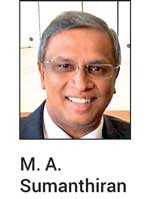Monday Dec 08, 2025
Monday Dec 08, 2025
Tuesday, 5 March 2019 01:38 - - {{hitsCtrl.values.hits}}
By Chathuri Dissanayake
Confronted with startling revelations in discrepancies in numbers presented in Budget estimates and actual numbers, the Committee on Public Finance (COPF) is calling for better transparency and accuracy in Government finance.
In analysing numbers presented in Budget 2018 in a report presented to the Parliament in February, the Committee has uncovered ‘startling variances’ in the amounts presented, Chairperson of the committee M. A. Sumanthiran told Daily FT.
“We have come up with startling revelations that there are huge variances at it has taken three years to crack this. The first two years there was one other kind of report that we presented, we were never able to present this report. This is in relation to 2018 and the Budget presented in 2017 November; and only now have we managed to give this,” he said.
A closely-guarded secret of the officials, even the COPF were not privy to the actual numbers in public finances. According to Sumanthiran, Treasury officials were reluctant to corporate with the committee and provide the material needed for their work, instead they provided data that was difficult to be compared.
“The officials didn’t cooperate with us, in that they gave us different figures at different times. At one point when we confronted them and said that none of this can be true, the reply we got was ‘only we know those figures’. Then we had to force them to give us those figures. That in itself was a startling revelation, because that did not match with any of the disclosed figures,” he said.
According to the Opposition Lawmaker, the Treasury officials work with four sets of numbers – one is the estimates printed and given, second is the numbers in the Budget speech, the fourth, as identified by Sumanthiran, are the actuals incurred, while the third set is “the real figures of the estimates of revenue and expenditure, which are not disclosed to anybody,” he said.
“The estimate of revenue is always overstated, so you show a small budget deficit. Because, in the proposal of expenditure they say they will do a whole host of things that require money. So to show that money is available to achieve that, they show a huge income which is never realisable. Then actual spending also doesn’t happen [as projected]. So when the actual revenue is much lower, the gap for 2018 was Rs. 200 billion as at August 2018. We don’t know how much was realised after,” he said.
Any possible analysis is further deterred due to different formats in which the numbers are presented. To address the issue, the Committee has asked the Treasury to present all details in a format given by the Committee. The presentation under the new format is expected to be given to the committee tomorrow, following the Budget speech today.
“The details are given in totally different formats, the estimates are given in income and expenditure format, the Budget speech is given in economic format – you can never compare the two, so the discrepancies can’t be figured out easily, unless people have been working for months on end, which is what we have done now. That is deliberately so. They have adopted these procedures deliberately to obfuscate the public knowing what is actually happening, it gives a measure of comfort to the officials not to be questioned on any of these matters.”
As a remedy to the current situation, the COPF has suggested making its sessions public, which needs to be facilitated through an amendment to the Parliamentary Privileges Act. Further Sumanthiran is also calling for the establishment of the proposed Budget Office.
“The bill [to establish the Parliament Budget Office] has been ready for some time, but the Government has not still moved in that respect. By law establish it and staff it adequately so that it is an entirely independent parliamentary institution under Parliament, so that it will give information to Parliamentarians and others on all of these matters independent of the Treasury. Treasury will be by law required to give the information to the Parliament Budget Office,” he said.
During the analysis the committee also uncovered that the Treasury does not maintain a proper asset registry either. Lack of such a document has made it difficult to keep track of vehicles used by each ministry, with new purchases being made for ministers as frequently as six months.
“We found that huge, unnecessary funds were spent on vehicles, because whenever the minister changed, he ordered a new vehicle even when the previous minister has only used the vehicle for six months. For all the old vehicles used, there was no trace of it, we tried to track it…Invariably it [the vehicle] was never over three years old, sometimes just six months, and in certain instances, the secretaries to the ministries, after we pressurised them, confessed saying they are using that vehicle,” he said.